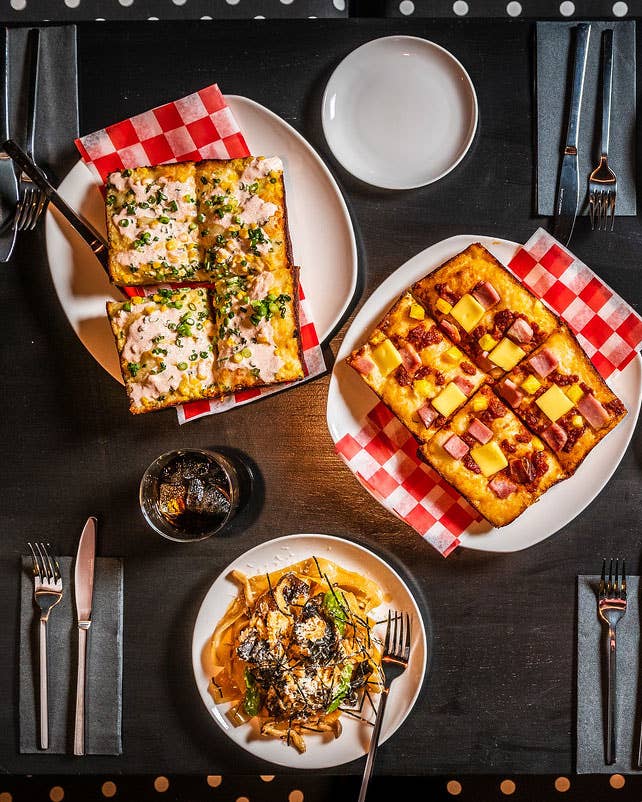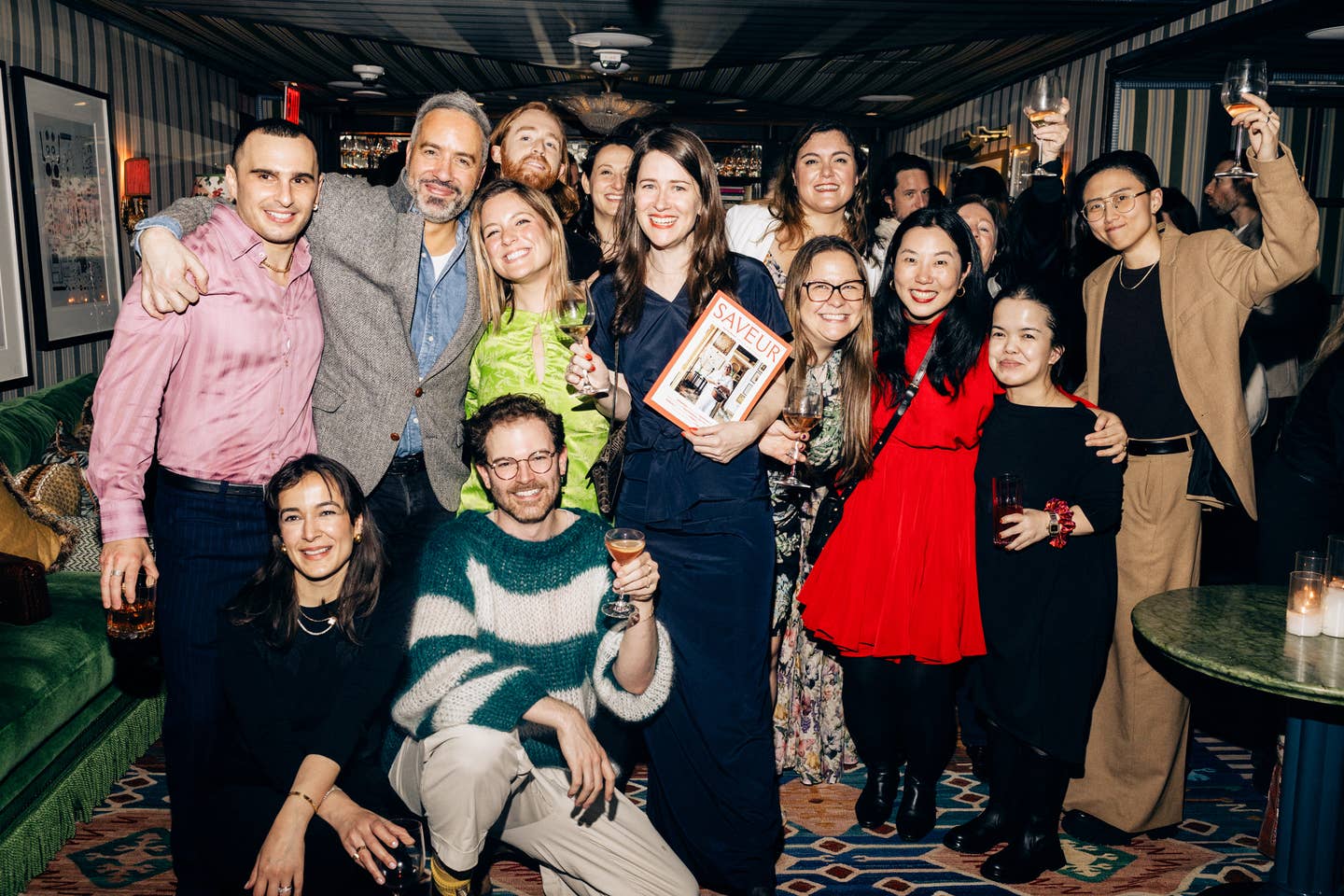These Two Noodle-Loving Cultures Tangle Seamlessly on the Plate
Their umami-rich pas de deux is the bedrock for a decades-old cooking style that’s finally coming to the fore.

The best Neapolitan pizza Katsuya Fukushima ever ate was in Japan, at the omakase-style, seasonally driven restaurant MONK in Kyoto. Blistered in the eatery’s wood-fired oven, the perfect dough was satisfyingly chewy yet airily light, speckled with pieces of briny mackerel and subtly sweet radish. “It blew my mind,” says the Japanese American chef, who had traveled to Japan to study and research the art of wafu-Italian, a genre of cooking that evolved from local interpretations of the European nation’s cuisine (wafu translates as “Japanese-style”). Of everything he ate, the artisan pizza especially stuck with Fukushima, later inspiring him to develop a corn and mentaiko (salted pollock roe) pie made with Hokkaido-imported flour that went on to become one of the best-selling items at Tonari, his wafu-Italian restaurant in Washington, D.C.
The culinary traditions of Japan and Italy, despite the vast geographic distance separating them, have a great deal in common (in addition to being two of the most popular cuisines in the world). “Philosophically, there’s a lot of affinity between the two,” says Daisuke Utagawa, a partner in the Daikaya Group, the team behind Tonari. Both cuisines are celebrated for spinning maximum flavor from minimal ingredients; both underscore seasonality and enjoyment of foods at their peak freshness; and both similarly emphasize the value of craftsmanship, "not only in cooking, but in agriculture and harvesting of natural resources," notes Utagawa. The coastal nations even share a similarly long and narrow geographic shape that begets diverse bounty from land and sea, he adds. And now, spurred by obsession with umami-packed foods and fascination with how Japanese dishes mesh with other cuisines, a growing number of chefs in the U.S. are championing Italy and Japan’s culinary compatibility.
American chefs experimenting with Asian flavors is nothing new. (Wolfgang Puck’s divisive Chinese-inspired restaurant Chinois on Main, which opened in Santa Monica in 1983, is often credited with pioneering and popularizing “Asian fusion,” thorny nomenclature that continues to evoke connotations of white chefs combining cuisines in gimmicky fashion, or glorifying ingredients sans cultural context.) But recent years have seen a wave of chefs, many of whom previously concentrated on Japanese or Italian food, now devoting their entire kitchens to channeling wafu-Italian cuisine. Though the spirit of this confluence has flecked restaurant menus in the U.S. for decades (New York’s Basta Pasta, for example, originated in Tokyo in 1985 and has long brought subtle Japanese accents to its Italian menu), chefs today are overtly spotlighting this descendent of two culinary juggernauts, all while approaching both parent cuisines with intentionality and care.
Chef Robbie Felice began serving wafu-Italian dishes in late 2020, in a pop-up omakase concept called Pasta Ramen devoted to celebrating the crossover cuisine. Felice, who specializes in Italian cooking at his New Jersey restaurants Osteria Crescendo and Viaggio Ristorante, first encountered Italian food with Japanese notes in Positano, where he ate an umami-rich crudo dish garnished with yuzu. The balanced taste surprised and delighted him, and the experience led Felice to devote years to researching and practicing wafu-Italian cooking. He wanted more diners to experience how elegantly the two cuisines blend, a chemistry he attributes in part to their symbiotic base flavors. Take shiso leaf, for example, a citrusy herb prominent in Japanese cooking. “What’s the flavor profile of shiso leaf? It’s basil and mint—the two most commonly used herbs in Italian cuisine,” he explains. From Miami to Seattle to Los Angeles, demand and interest followed the pop-up around the country. In January, Felice and restaurateur Luck Sarabhayavanija, who owns Ani Ramen, opened Pasta Ramen’s permanent home in Montclair, New Jersey. On the cross-cultural menu that highlights the two cultures’ shared penchant for noodles, standouts include chicken katsu ramen served in a deeply savory parmigiano shoyu broth, and a creamy, slurpable carbonara-inspired tsukemen featuring spicy togarashi and zesty lemon.
Across the Hudson River, another restaurant drew buzz when it introduced a wafu-Italian menu in Manhattan’s Nolita neighborhood in 2020. At Kimika, diners can start with small bites like briny house-marinated olives or crisp tsukemono (Japanese pickles) before moving on to a hearty pasta course of creamy mentaiko spaghetti made with salty roe, or a saucy pork ragu cavatelli served with nutty edamame and milky ricotta. Showstoppers such as crispy panko-crusted eggplant katsu and shiso-scented grilled branzino—dishes a traditional Italian menu might refer to as secondi—round out the meal. Over in Minneapolis, Sanjusan, which opened in 2021, serves gyoza that marries buttery foie gras with earthy wood ear mushrooms, and fires up savory artichoke pizzas topped with bonito cream. And in D.C., Fukushima draws from his Japanese heritage and studies of Italian tradition to produce his own take on wafu-Italian cuisine at Tonari. “I’m not trying to reinvent Italian food,” says the chef. Rather than riffing for pure novelty’s sake, he aims to honor both origin cuisines in equal measure: a dish he’s especially proud of is mentaiko tagliolini, made with pasta crafted at a ramen factory in Japan, that packs an umami punch with deeply savory ingredients like cod roe and tsuyu. Another favorite is his version of inarizushi, or rice-stuffed fried tofu pockets, which he tops with meaty, buttery anchovies.
Originally, the convergence of Japanese and Italian flavors stemmed less from chefs admiring the cuisines’ synergy, and more from necessity and practicality. After the Meiji Restoration opened Japan up to Western trade in 1868, foreign food influences flowed into the country; another influx came during the post-World War II era as Allied soldiers occupied the country. In part to meet growing demand, local chefs increasingly served globally influenced offerings like curry rice, doria, and Napolitan spaghetti. Such dishes, borne from cultural exchange and limited ingredient availability, integrated Western flavors with Japanese techniques and became a category of cooking known as yoshoku, or “Western food.” Over time, in the spirit of Japan’s reverence for specialized craftsmanship, many chefs devoted themselves to mastering true Italian fare, Utagawa explains. On that foundation of understanding and esteem for Italy’s traditions, some imbued their food with Japanese sensibilities, creating a new culinary style. “They [aren’t] trying to push the ingredients together as much as they really respect all the different ideas,” notes Ivan Orkin, cookbook author and owner of Ivan Ramen in New York City.
In many ways, wafu-Italian cooking is a fluid concept, the ever-shifting intersection of a Venn diagram that cooks today are continuing to explore. “I don’t think it’s possible to coin or define [wafu-Italian],” Utagawa adds. “It can manifest in many, many ways.” What the myriad interpretations have in common is that they “highlight the similarities as opposed to the differences” between two cultures, says Ricky Dolinsky, chef-owner of the Manhattan restaurant Yo+Shoku.
This offspring cuisine, suspended between two culinary powerhouses, bears the DNA of both parents without identically resembling either one. Given its delicious lineage, it was only a matter of time before the whole world caught on.
Recipe
Keep Reading
Continue to Next Story










